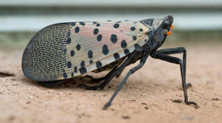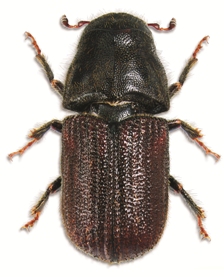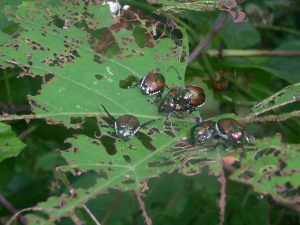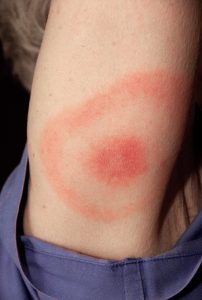 While there are a number of pests that cause hindrance for farmers and gardeners, some pose a greater threat which causes a huge economic damage. The Spotted Lanternfly is one of them.
While there are a number of pests that cause hindrance for farmers and gardeners, some pose a greater threat which causes a huge economic damage. The Spotted Lanternfly is one of them.
The Spotted lanternfly (Lycorma delicatula) is a planthopper native to China, India, and Vietnam. It was detected in South Korea in 2004. The first confirmed sighting in Pennsylvania took place in 2014 in Berks County, Pennsylvania. Apart from this, Japan, Delaware, Maryland, Virginia, New Jersey and New York are even reported with spotted lanternfly infestation.
Spotted lanternflies eat sap from plants. They prefer Ailanthus trees (tree of heaven), walnuts and grape vines as a first choice, most any other hardwood tree as a second choice and with much less frequency, pine trees. They have a very wide range of host plants.
They drink sap, which is the lifeblood of the tree. Trees can develop weeping wounds of sap on their trunks. Heavy infestations can cause honeydew secretions to build up at the base of the tree, blackening the soil with fungal mats around the base of the tree. This may greatly weaken a tree, making it susceptible to other insects or diseases, or maybe killing it outright. Spotted lanternflies suck sap and digest it, concentrating the sap into a sugar-rich excretion (urine) that is politely termed “honeydew” in the entomological vernacular. The “rain” you are seeing is actually a high volume of spotted lanternfly honeydew falling from the branches above.
Spotted Lanternfly has only one generation per year and overwinters as eggs in egg masses. In the spring and early summer, eggs hatch and lanternflies go through four nymphal stages (called instars). Males and females mate multiple times and females can produce one or two egg masses. Female spotted lanternflies lay egg masses on smooth-barked trunks, branches, and limb bases of medium to large-sized trees, as well as on smooth stone and other natural surfaces, and on man-made items such as yard furniture, cars, trucks, and farm equipment.
The menace caused by the lanternflies was reported that:
USDA declares war on spotted lanternfly, will spend $17.5M
Michelle Merlin | February 8, 2018
The federal government said Wednesday it plans to spend millions of dollars on a massive offensive to fight a foreign invader already in Pennsylvania’s midst.
The invader: the inch-long, black-dotted, red-winged spotted lanternfly.
It’s target: the state’s valuable agricultural commodities, including fruit and hardwoods.
The battle plan: surveillance, control, and action to halt the invasive bug from Asia.
U.S. Secretary of Agriculture Sonny Perdue announced the department would allocate $17.5 million in emergency funding to stop the spread of the spotted lanternfly in Pennsylvania — a 503 percent increase over last year.
The announcement comes as other states report possible invasions, posing a threat to their agricultural products. Pennsylvania officials say the insect, which is native to China, India, and Vietnam, threatens to destroy $18 billion worth of agricultural commodities produced in the state.
Spotted lanternfly spreads, threatens Pa. fruit and timber crops
By Colt Shaw | August 14, 2017
On a bright Wednesday morning, at the Manatawny Creek Winery, which he co-owns in Amityville, there was an 8-foot metal fence around one of his vineyards to keep peckish deer from snacking on his grapes and nets draped over some of his rows to keep the birds’ aerial assaults at bay.
For now, however, he has no recourse for an invasive species known as the spotted lanternfly, or Lycorma delicatula, an insect native to Asia that first arrived in the United States in Berks County in 2014 and has spread to neighboring counties. The pest is a potential threat to the state’s $13.1 billion annual productions of apples, grapes, peaches, and other crops, as well as $16 billion in timber and wood products, according to the Pennsylvania Department of Agriculture.
Measures used for prevention are egg mass scraping where they remove the egg sacks that the lanternfly lay before they are able to hatch. Because the egg sacks attach to smooth surfaces, they are scraped and placed into an alcohol solution in order to kill the pests inside of the egg sack. To get rid of spotted lanternflies in their nymphal stages, banding these trees are being practiced.
Among chemical controls, some broad-spectrum pyrethroids, several botanical insecticides, and a few other pesticides are being used. But pesticides seem to be ineffective for long-term control, and lanternflies can quickly repopulate after spraying.
An effective eco-friendly solution is the need of the hour.
The unique product Combirepel™ manufactured by C Tech Corporation is an anti-insect aversive which repels insects.
Combirepel™ is an extremely low toxic, non-hazardous, non-mutagenic and non-carcinogenic anti-insect aversive.
Combirepel™ is developed on green technology and chemistry. It is effective against a broad spectrum of insects such as bed bugs, wasps, whiteflies, termites, beetles etc.
Combirepel™ is thermally stable and does not degrade on exposure to heat and sunlight. It does not kill or harm the insect but repels them. It does not volatilize and does not degrade the soil. It is RoHS, RoHS2, REACH, ISO, APVMA, NEA compliant and FIFRA exempted.
Combirepel™ is available in the form of the masterbatch, which can be incorporated into the polymeric applications like polymeric tree guards, agricultural films, wires and cables, pipes, etc. The masterbatch, when incorporated into the polymeric tree guards and agricultural films, will repel the lanternflies and will protect the trees from the damage caused by these insects.
The product available in the form of liquid concentrate can be mixed in paints in a predetermined ratio and be applied on the interior and exterior of houses, farms, gardens to keep the lanternflies away from these places.
Our product in the lacquer form can be applied topically to the applications. The lacquer is compatible with most of the surfaces like wood, concrete, metal, polymer, ceramic, etc. The lacquer can be applied to the already installed applications like the pipes, wires and cable, home decors. The lacquer gives a transparent finish and does not disturb the aesthetics of the application.
The lacquer can be applied to the tree trunks protecting it from the attacks. The product is also effective against other pests thus protecting the trees from other pest attacks.
Thus, using Combirepel™ would effectively ensure that the area around us remain safe and protected from the pests for a long period of time.
Why kill when we can just repel them!?
Our product works on the mechanism of repellency. It temporarily inhibits the mating cycle of the insects. The product impairs the ability of the insects to reproduce, that is the insects will not lay eggs or the laid eggs will be infertile. The product causes feeding disruption in an insect by triggering an unpleasant reaction within the insect which might try to feed on the application. The product temporarily blocks the reproduction system of the insects by hindering the release of the vital hormones for growth.
In such a way the spotted lanternflies can be repelled and the damage caused by them can be prevented without killing them.
Contact us at technical.marketing@ctechcorporation.com to keep the pests away.
Also, visit our websites:
http://www.ctechcorporation.com/
http://www.rodrepel.com/
http://www.termirepel.com/
http://www.combirepel.com/
Follow our Facebook pages at:
1] https://www.facebook.com/Combirepel-411710912249274/
2] https://www.facebook.com/Termirepel-104225413091251/
3] https://www.facebook.com/Rodrepel-120734974768048/
Follow us on our Twitter pages at:
1] https://twitter.com/rodrepel
2] https://twitter.com/termirepel
3] https://twitter.com/combirepel

















